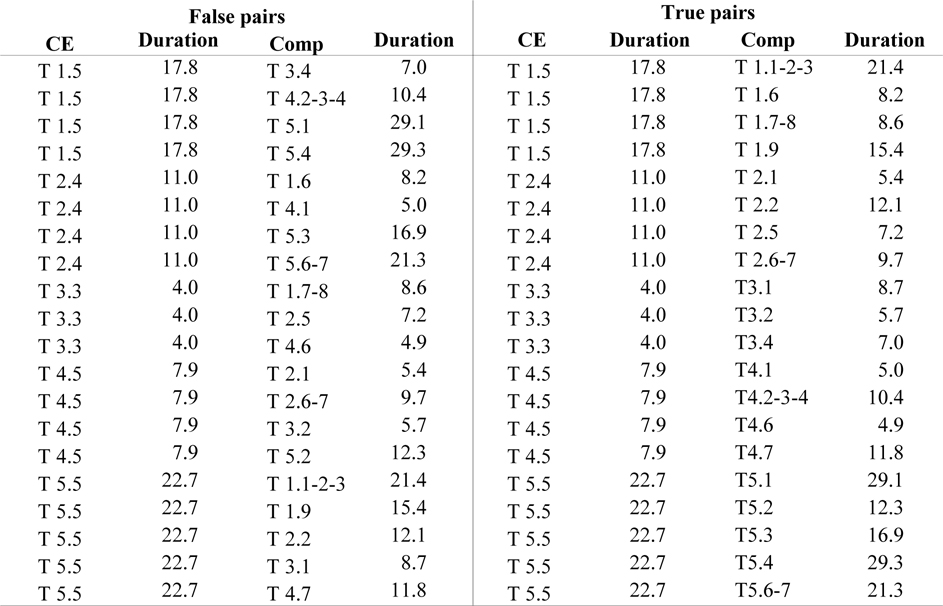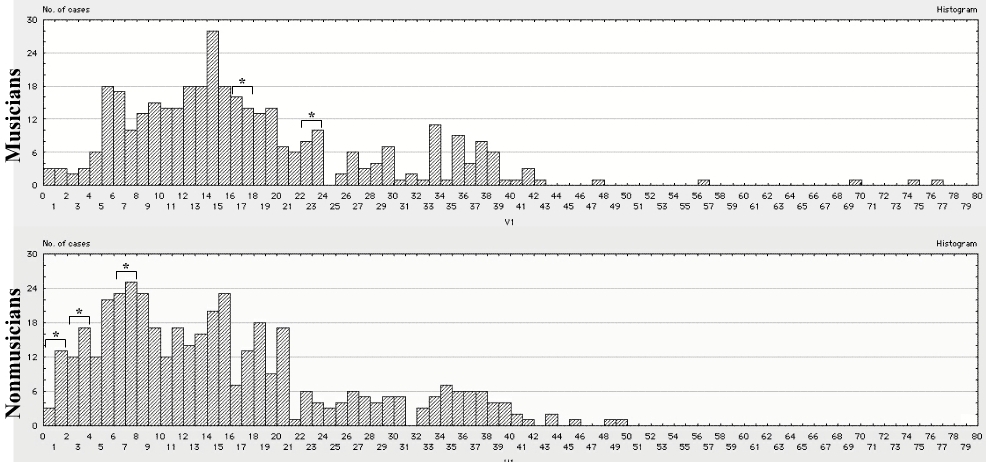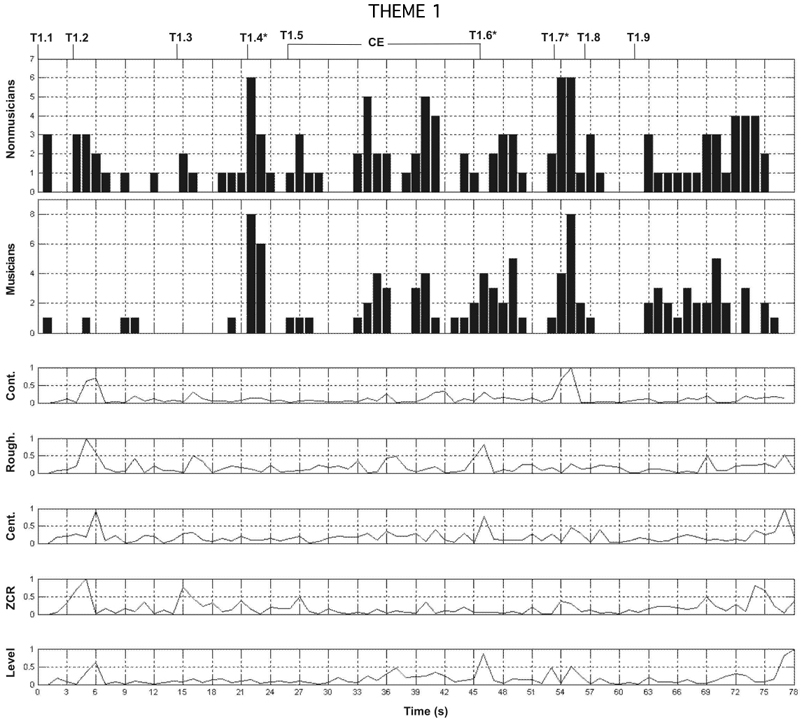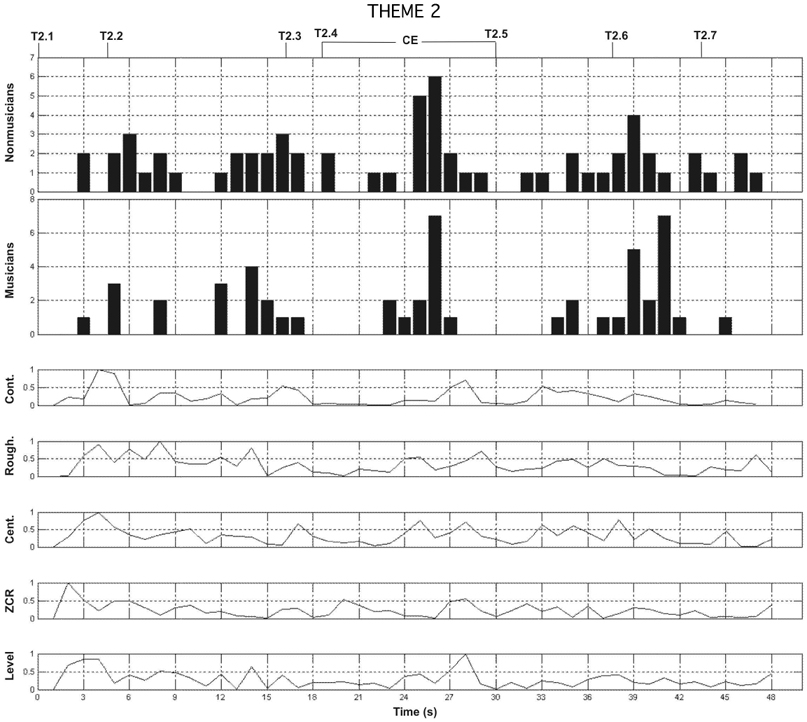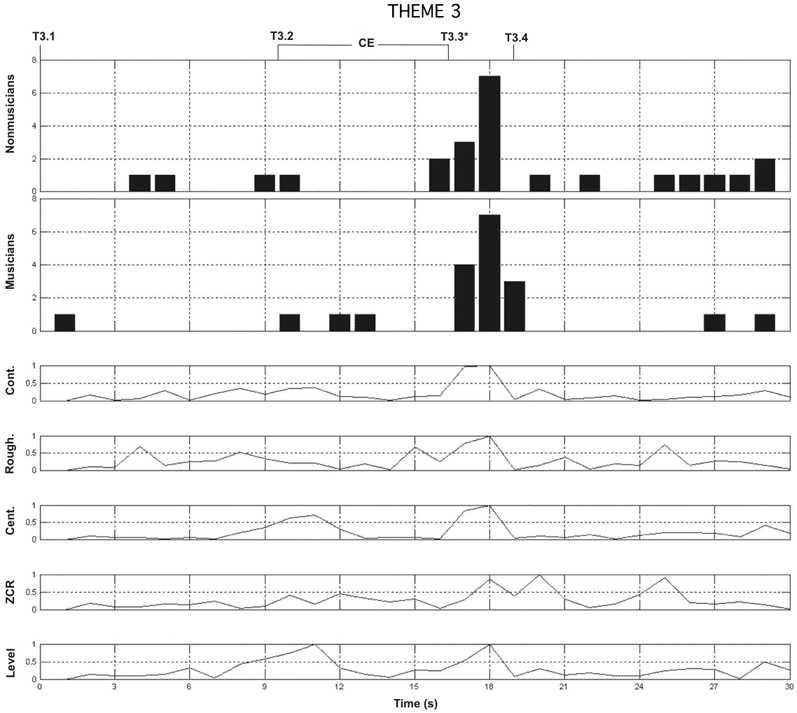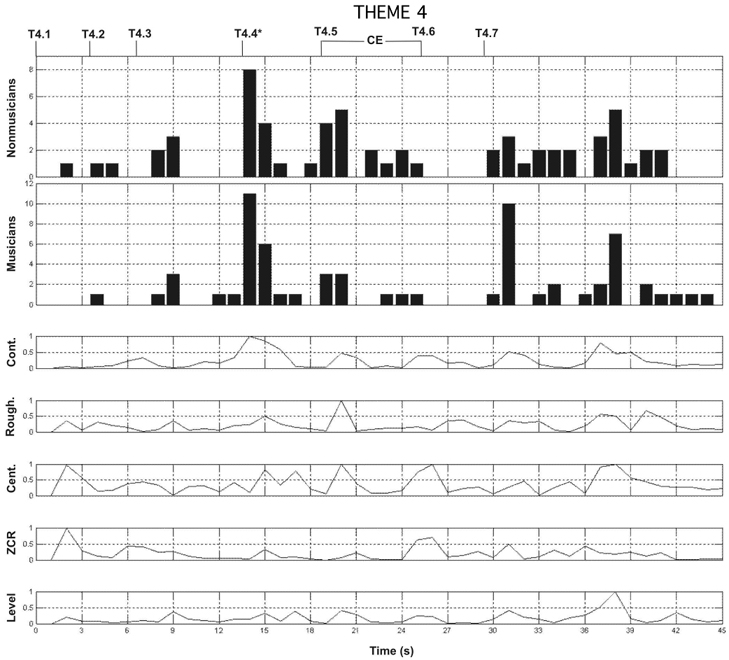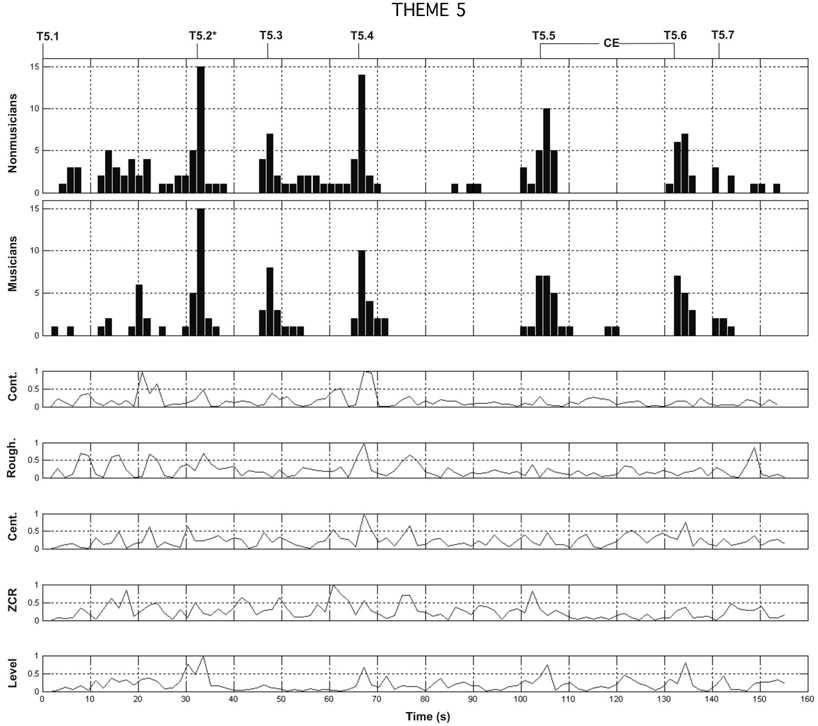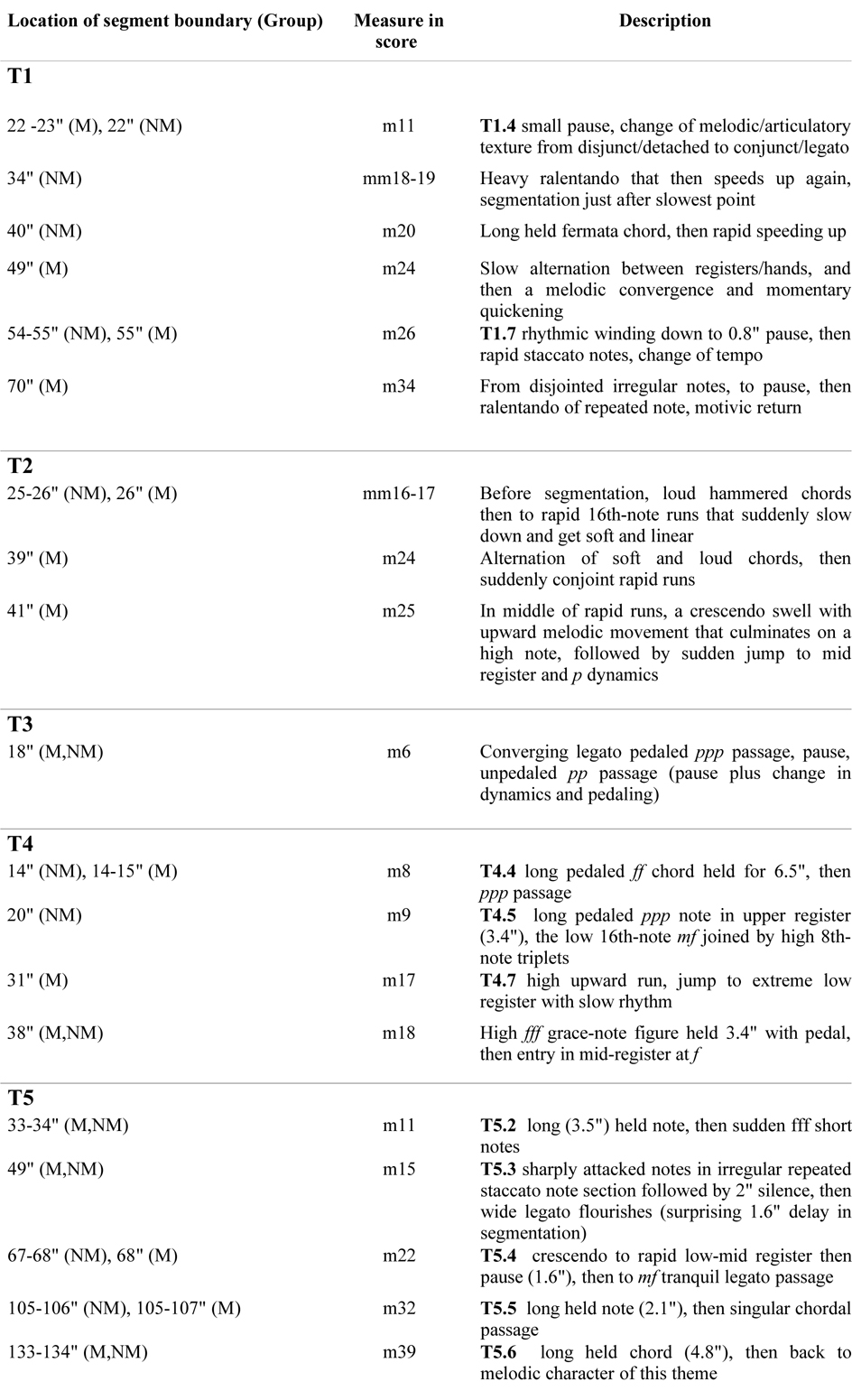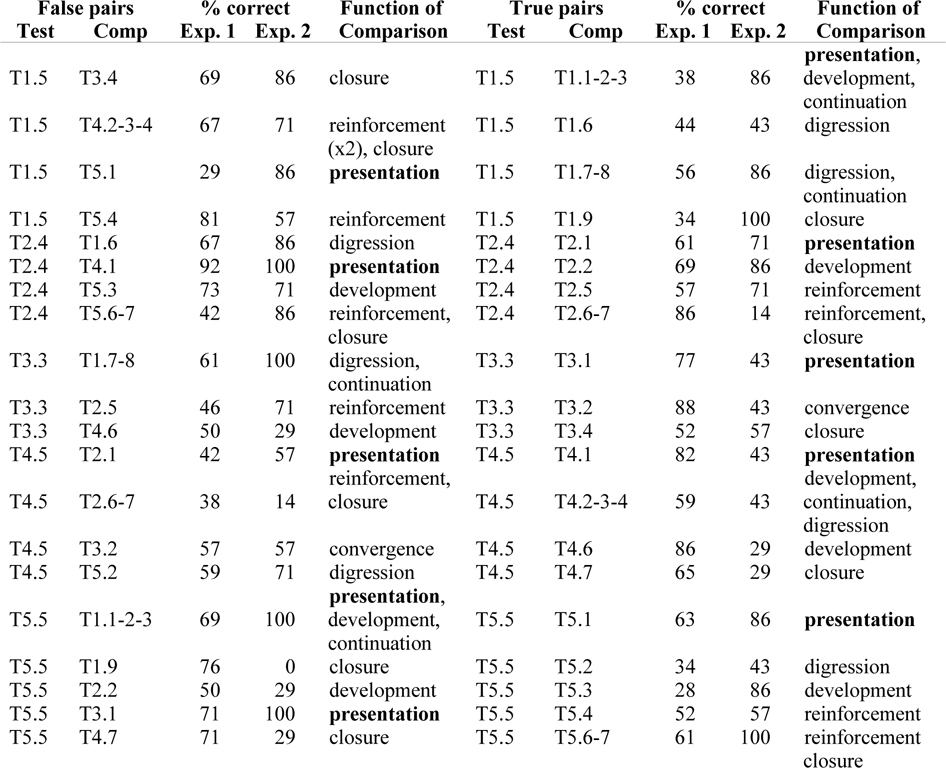Thematic materials of The Angel of Death
Reynolds' music is particularly appropriate to study the relevance of large-scale structures in contemporary music. The principal concern of Reynolds is time, or more exactly "the architecture of time". From the early 1960s, he started to control all the temporal aspects of his pieces with numerical series in irregular progressions to breathe unpredictability into them. Later, he improved his method and developed various techniques to create waves of durations, dilating or retracting, converging or diverging, in a nonlinear way. These always-changing portions of time become a norm—convergence/divergence—whose function is equivalent to tension/resolution in tonal music: "My intention was to build into the structure " but only at the subconscious, which is to say only at the inferable level " waves of accumulating or shrinking duration that, by their expansion or convergence would evoke the sense of movement towards, of arrival at, and dissolution from. These trends might, I thought, in some measure compensate for the formal functions previously served by tonal harmonic conventions: operating over spans of time, suggesting, as they are traversed, origins and goals" (Reynolds, 1987, p. 288). Reynolds was also one of the first composers to exploit systematically the multidimensionality of musical time. His music is contrapuntal at the local level as well as at the global level. His works are always formed of many independent layers. One of the most manifest characteristics of Reynolds' compositional procedures is to constitute his thematic material around a core element. "Core elements are composed according to strict methodological standards, whatever this may mean in a given piece. This rigor is particularly important because of the fact that they serve " at least in my case " as the reservoirs of orderliness for the work as a whole. The algorithmic procedures that I use often disturb temporal proportion and succession radically. Overall consistency in the composition, then, requires that each derived fragment of the original whole, wherever it is found, should itself be a reliable product of the underlying orthodoxies" (Reynolds, 2002, p. 19). In the case of The Angel of Death, the core element has a specific rhetorical function. It constitutes the expressive center of the theme and acts like a magnet or a driving bolt on the other sections of the theme (Fig. 1). It contains both a centripetal and a centrifugal force. The core element is not more identifiable than the other sections, but it constitutes a boundary, a line of demarcation, which listeners seem to be able to feel implicitly (see Reynolds, this CD-Rom).
The Angel of Deathcontains five thematic materials. The term "theme” (which we will adopt for this paper, see also Reynolds, this CD-Rom) is not used in its traditional meaning, but to mean something like a formal unit. The themes vary from 23.5 s to 99.5 s as conceived (31 s to 156 s as performed), and the composer created them with from four to nine subsections. The internal temporal organization of the themes has a more or less marked directionality. Theme 1 carries the most directional trajectory. In an opposite way, Theme 5 is the least directional. In this latter case, the contrasts between the subsections are greater. The proportions of each theme lead us through an elastic time, which contracts, stagnates or dilates. The five themes have a global morphology in the form of an "X", the place of crossing always being the core element (Fig. 1). Thus, in Theme 1, the registers of the two lines meet, then deviate. In Theme 2, the dyadic links seem to spread to the blocks of chords, then fade out. In Theme 3, two lines out of phase converge in a chromatic contrary motion, then diverge. In Theme 4, the trajectories go from order to disorder, then back to order. In Theme 5, the contrapuntal intensification stops on a chorale, then briefly reappears. The force of the directionality seems to weaken, as the first theme is most clearly directional, and the last less so. Figure 1 presents the internal and external temporal proportions, the formal directionality, and functions for each of the five themes.

On the basis of a music-theoretic analysis, we established eight categories of rhetorical functions in the five themes. These functions allowed us to provide an account of the extroversive semiosis of each theme (related to the Agawu categories mentioned before). They don't correspond exactly to the categories of ancient rhetoric (Mattheson, 1739), but they are inspired by the rhetorical category called dispositio, i.e. the way to order the ideas, to assemble them according to a plan. Presentation (exordium) is often the beginning, the first step, of the theme. It proclaims the material and presents the main(s) idea(s). Development (narratio) is a process of transformation and variation of material opened in the immediately preceding subsection. Continuation (confirmatio) is a similar process that prolongs the material of the preceding subsection (boundaries between development and continuation are weaker). Digression (digressio) links two subsections; it is an intermediary state often based on a contrasted musical idea. Reinforcement (confirmatio) implies that a characteristic of a previous subsection is reinvested, repeated. Convergence corresponds to the core element; it carries temporal convergence and half-conclusive functions. Closure (peroratio) is the end of the theme; it carries a conclusive function. In this scheme, we are working according to the principle that each subsection carries only one function. The descriptions of the five themes that follow refer again to Reynolds' subsections, and attempt to highlight the sequence of musical ideas using the eight categories of rhetorical functions. The sequence of ideas in the themes of The Angel of Death shows a complex path that carries both linearity and nonlinearity (related to Kramer's categories mentioned before).
- Theme 1: Equilibrium in Extremis. Performed duration = 78", 9 subsections (notated T1.1 to T1.9). Two lines separated by extreme registers join in the core element then divide to return to the extremes.
- T1.1: Function of presentation of the main idea (two lines separated by extreme registers, one in repeated tones, the other in sustained tones).
- T1.2: Function of development (lines in convergence, melodic and harmonic variation).
- T1.3: Function of continuation of the process in T1.2.
- T1.4: Function of digression. The right-hand melody line becomes a continuous curve with conjunct intervals.
- T1.5: Core element - Function of temporal convergence. Suspensive moment in the middle of the core element.
- T1.6: Function of digression. Rupture in writing (medium register, low dynamic, contrapuntal).
- T1.7: Function of digression. New rupture in writing, staccato, high register.
- T1.8: Function of continuation of the process in T1.7.
- T1.9: Function of closure. Return of initial characteristics (extreme registers, repeated tones) and, finally, fragmentation and dislocation.
- Theme 2: Contradictory Assertion. Performed duration = 48", 7 subsections.
Alternation between brief chords repeated in a nonperiodic way and two-voice virtuosic passages (the "dyadic connectors”). Contrary to the first theme, the second theme has a lot of repetitions, which can help memorize it.
- T2.1: Function of presentation of the main idea (brief chords, contrasted dynamics, silences).
- T2.2: Function of development (less silences, appearance of the dyadic connectors).
- T2.3: Function of reinforcement of the main idea (only brief chords).
- T2.4: Core element " Function of temporal convergence. Suspensive moment in the middle of the core element.
- T2.5: Function of reinforcement (return of the main idea).
- T2.6: Function of reinforcement (return of dyadic connectors).
- T2.7: Function of closure (return of the main idea).
- Theme 3: Tremulous Uncertainty. Performed duration = 31", 4 subsections. An homogeneous morphology (tremolos and arpeggios at a low dynamic level), which gives a feeling of interiority. Its two chromatic lines in contrary motion characterize the core element.
- T3.1: Function of presentation of the main idea (arpeggios out of phase between the two hands).
- T3.2: Core element - Function of temporal convergence (arpeggios in phase, two lines in contrary motion).
- T3.3: Function of digression (arpeggios in phase, which move gradually out of phase).
- T3.4: Function of closure (dislocation and fall).
- Theme 4: Jagged Rips. Performed duration = 65", 7 subsections. Virtuosic, cascading passages running through all registers, which are aperiodically interrupted by brief direction reversals.
- T4.1: Function of presentation of the main idea (a downward line in alternation between the two hands).
- T4.2: Function of development (variation).
- T4.3: Function of continuation of T4.2 with a pause.
- T4.4: Function of digression with a pause.
- T4.5: Core element - Function of temporal convergence (two lines in contrary motion and then a downward line).
- T4.6: Function of development (upward lines).
- T4.7: Function of closure with a pause in the middle of the sub-section.
- Theme 5: Interior Line . Performed duration = 156", 7 subsections. From a single line, the texture becomes gradually more complex. The core element, like a chorale, breaks the linearity, which subsequently returns.
- T5.1: Function of presentation of the main idea (a long lyrical line).
- T5.2: Function of digression (rupture: repeated tones, discontinuity, ornamentation).
- T5.3: Function of development (ornamentation).
- T5.4: Function of reinforcement of the main idea (return of the melodic line).
- T5.5: Core element - Function of temporal convergence (perturbation: chords, low dynamic level).
- T5.6: Function of reinforcement of the main idea (return of the melodic line).
- T5.7: Function of closure (downward line).
The structures of the five themes of The Angel of Death are thus time-oriented. Each subsection of each theme can be described in terms of rhetorical functions, and the core element has a specific rhetorical function that determines the temporality of the themes. An important question that arises then is: to what extent are listeners able to pick up these time-oriented implications and rhetorical functions? The broad purpose of this study was to assess the ability of listeners to capture these specificities of Reynolds' music and the extent to which musical expertise favors (or not) this ability. In Experiment 1, we assumed that listeners acquire the temporal implications of a musical excerpt from previous hearings of the theme as well as from the specific musical patterns contained in the excerpts. Three tasks were designed to address this issue. In the segmentation task, participants indicated online each musical idea they perceived in Reynolds' themes. We were not expecting these perceived ideas to fit point by point with the sections delineated by the composer, since these sections correspond mostly to compositional strategies (see Reynolds, this CD-Rom). In other words, there was no right or wrong answer in this task. The task was simply designed to illuminate the perceptual structures of the themes and to assess whether these structures change with the extent of musical expertise. Of course, we were expecting some correspondence between the main structure defined by the composer (notably the core elements) and the perceived musical ideas. The next two tasks lead to specific hypotheses. In the belongingness judgment task, participants were presented with pairs of excerpts from the themes and had to decide whether or not they belonged to the same theme. Low performance in this task would reflect participant's difficulty in capturing the rhetorical function of the different sections of the themes. The last task was more demanding since it required participants to indicate the temporal order of two excerpts within the theme, if they were judged to belong to the same theme. If the listeners had acquired the temporal implications of a musical excerpt from the previous hearings of the entire themes, they should respond above chance in this task.
